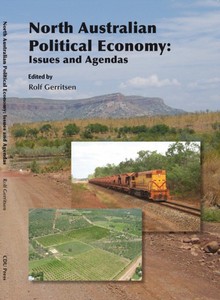Atypical labour markets require atypical policy solutions
Welters, Riccardo (2010) Atypical labour markets require atypical policy solutions. In: Gerritson, Rolf, (ed.) North Australian Political Economy: Issues and Agenda. Charles Darwin University Press, Darwin, Northern Territory, Australia, pp. 55-69.
![[img]](https://researchonline.jcu.edu.au/15874/8.hassmallThumbnailVersion/15874_Welters_2010_Book_Cover.jpg)
|
Image (JPEG) (Book Cover)
- Cover Image
Download (67kB) |
|
|
PDF (Reduced File Size for ERA Review)
- Published Version
Download (2MB) | Preview |
Abstract
Introduction The Federal Government set out an ambition to address the socio-economic divide between Indigenous and non-Indigenous communities in its 2009 Closing the gap on Indigenous disadvantage: the challenge for Australia report (Australian Government, 2009a). The report identifies six areas of concern and sets goals to address them: 1. Close the life expectancy gap within a generation; 2. Halve the gap in mortality rates for Indigenous children under five within a decade; 3. Ensure access to early childhood education for all Indigenous four years olds in remote communities within five years; 4. Halve the gap in reading, writing and numeracy achievements for children within a decade; 5. Halve the gap for Indigenous students in year 12 attainment or equivalent attainment rates by 2020, and; 6. Halve the gap in employment outcomes between Indigenous and non-Indigenous Australians within a decade. This chapter focuses on the sixth goal and will concentrate on the northern Australian Indigenous labour market. Although I focus on the last goal, I wish to stress that these six goals are interrelated. Improving labour market outcomes will require success in at least goals three to five as well. Biddle et al. (2009) show that about 117,000 jobs must be created for Indigenous people by 2016 to meet the Closing the Gap employment goal. Australian Government (2009b) shows that 28 per cent of all Indigenous Australians live in northern Australia, which implies that success in that part of the labour market is crucial to the Federal Government to achieve its overall national goals. To achieve its Indigenous labour market goal, the Federal Government has redeveloped two existing programs-the Community Development Employment Projects (CDEP) and the Indigenous Employment Program (IEP)-which will be rolled out in close conjunction with the UES (Universal Employment Services (UES). This chapter intends to assess the likelihood that the proposed policy mix will have the scope and scale to meaningfully reduce unemployment in the northern Australian Indigenous labour market. This will be necessary for the government to achieve its goal of halving the gap in employment outcomes between Indigenous and non-Indigenous Australians within a decade. The next section will describe that northern Australian Indigenous labour market and picture the current state of affairs, which provides an insight into the challenges ahead. The subsequent presents the suit of labour market policies that the Australian Government employs to achieve its goal of 'halving the gap' and assesses the adequacy of this policy mix to be successful. The following section will discuss policy alternatives, while Section 5 provides conclusions and recommendations.
| Item ID: | 15874 |
|---|---|
| Item Type: | Book Chapter (Research - B1) |
| ISBN: | 978-0-9808641-0-6 |
| Date Deposited: | 21 Apr 2011 05:07 |
| FoR Codes: | 14 ECONOMICS > 1402 Applied Economics > 140211 Labour Economics @ 100% |
| SEO Codes: | 91 ECONOMIC FRAMEWORK > 9101 Macroeconomics > 910107 Macro Labour Market Issues @ 100% |
| Downloads: |
Total: 245 Last 12 Months: 14 |
| More Statistics |



